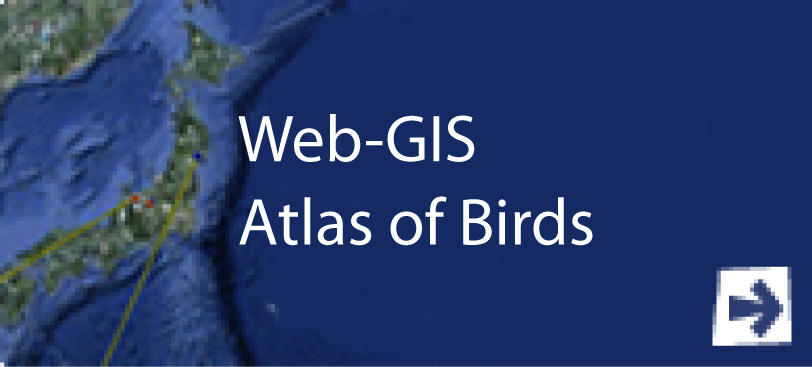Table of contents
- 1. Development of various methods for tracking individual birds
- 2. Development of safe capture technques
- 3. For the purposes of identification and assessment on sites where birds are protected
- 4. International cooperation and interaction
1. Development of various methods for tracking individual birds
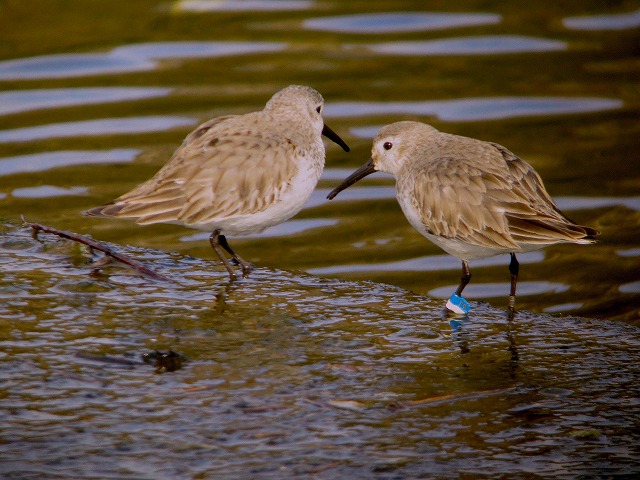
A Dunlin tagged with a color-flag |
To read the tiny numbers and letters written on the metal bands used in bird banding, it is necessary to recapture banded birds, which is a disadvantage. Researches use identification tags that enable them to identify individuals from a distance with binoculars and a telescope to study the ecology of birds. This method is advantageous in that it is possible to continue to observe the same bird through tracking rather than capturing it repeatedly. The Ministry of the Environment mainly uses plastic colored neck bands and leg bands with engraved letters and numbers for swans, geese and cranes; and plastic colored leg flags for wading birds. Data from observations using these methods serve as important sources to learn about the ecology of birds, including migration routes to and from breeding grounds, stopover and wintering sites, pair bonds and family composition, thereby not only contributing to scientific research but also serving an important role in the development of specific bird protection measures.
|
|
For the study of large-scale migrations of wild animals such as sea turtles, whales and large land mammals, a tracking method that employs satellites is used. The location of an animal is calculated through the use of satellites that receive the radio waves emitted from the transmitter. Transmitters used for this method have recently been made light enough such that they can be attached to birds. To study bird migration routes, ground surveys are not enough. Now, we can use radio waves as tags to track birds. This method is used, for example, in surveys of Short-tailed Albatross that breed in Japan and migrate over the North Pacific Ocean, of Streaked Shearwater that migrate to as far south as the southern hemisphere, of Steller’s Sea Eagle that breed in Siberia and overwinter in Japan, and swans that breed in the Arctic and overwinter in Japan. |
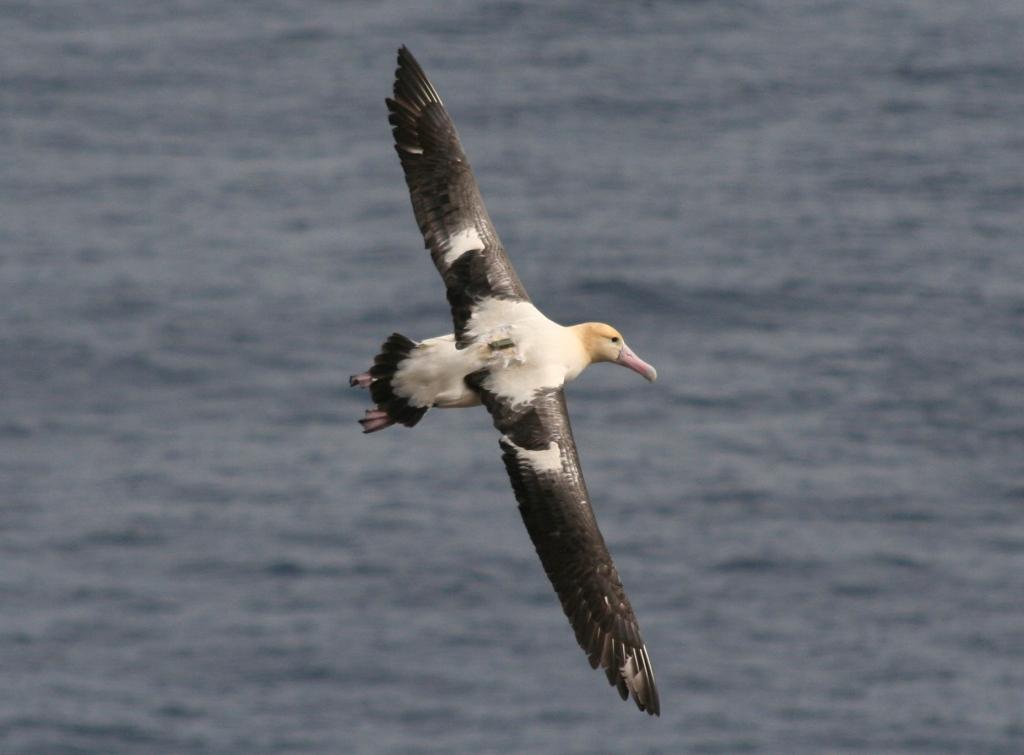
A Short-tailed Albatross carrying a satellite tracking transmitter |
2. Development of safe capture techniques
|
In 1979, when the number of endangered Crested Ibis was reduced to five, the Environment Agency decided that there was no choice but to capture all remaining birds in order to start a captive breeding program. A project to identify safe capture methods and capture the last remaining Crested Ibis individuals was initiated and contracted out to the Yamashina Institute for Ornithology. After studying the behavior of the birds on-site and reviewing capture methods that had been applied both in Japan and abroad, the Yamashina Institute for Ornithology came to the conclusion that a rocket net would be the most suitable method to safely capture the birds. The Institute then obtained a rocket net from abroad and performed a series of meticulously planned experiments to capture the birds. During the period between November 1980 and January 1981, all five of the birds were successfully caught without inflicting harm. The outcomes achieved in this project were documented in two reports, which have been used as references in conducting capture surveys of other bird species. |
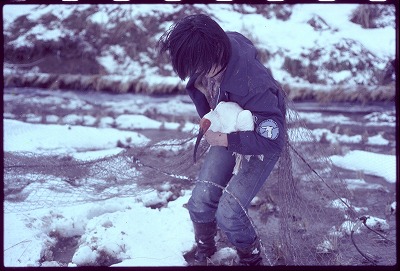
|
|
When Okinawa Rails were discovered in 1981, a trap that was designed and made on-site by the Yamashina Institute for Ornithology was used to successfully capture them. After detailed records were made, the birds were released. |
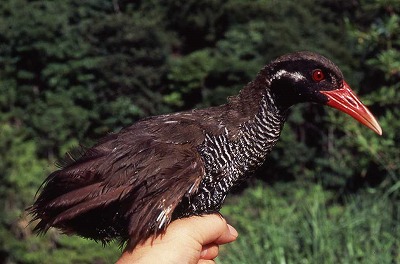
|
3. For purposes of identification and assessment on inspection sites
|
The capture and breeding of wild birds is prohibited, with some exceptions. Although the frequency of poaching and illegal breeding has declined, they have not been eliminated. It is not possible to arrest violators of relevant laws and regulations unless the poached and/or illegally bred birds are proven to be of Japanese origin. Data from long-term bird banding surveys have enabled us to distinguish legally imported birds (Foreign origin) from poached birds (Japanese origin). The Ministry of the Environment has published manuals for identifying the Japanese White-eye, Japanese Bush Warbler, Meadow Bunting, Blue-and-white Flycatcher, and Narcissus Flycatcher, which have been frequent targets of poachers and/or illegally bred. These manuals are used effectively to regulate poaching and illegal breeding.
|
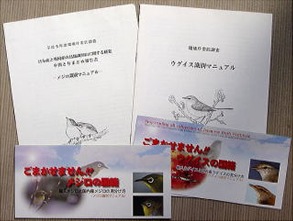 |
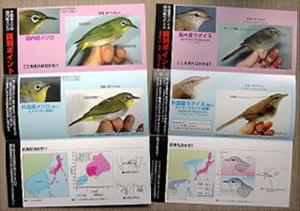 |
Findings on the identification of bird species that have accumulated through banding surveys are now used for identifying species at customs offices and for rescuing injured birds by local governments and NGOs. Manuals for species identification to be prepared for oil pollution accidents have also been developed by NGOs.
Click above to go to the “Manual for Identifying Endangered Species” from the Ministry of the Environment webpage. (Prepared by the Ministry of the Environment) Click above to go to the “Species Identification” of the National Wild Bird Poaching Countermeasures of Japan webpage. (Prepared by WWF Japan and the Japanese Association for the Preservation of Birds) Click above to go to the “JEDIC-Japan Environmental Disaster Information Center” website. |
4. International cooperation and interaction
|
Bird banding surveys cannot be launched and implemented successfully without an international network. To make meaningful achievements, it is particularly important for neighboring countries to cooperate with each other. To achieve this goal, with the assistance of ODA projects of the Ministry of the Environment and the Ministry of Education, Culture, Sports, Science and Technology and from private funding, the Yamashina Institute for Ornithology has focused its efforts on educating people in Southeast Asian countries about the significance and importance of bird banding surveys and on transferring techniques. The Institute has provided workshops on bird banding surveys in China, the Philippines, Thailand, Indonesia, Vietnam, Malaysia, Mongolia and Taiwan, and invited scientists from these countries to provide technical training. As a result, governmental agencies or private groups have organized bird banding projects and conducted banding surveys in many countries. Some countries, however, have not yet created any survey system or, even if one is present, efforts toward fully implementing it have not yet been conducted. Further cooperation and interaction is expected. |
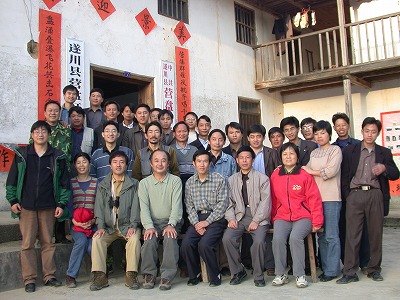
A session on banding surveys in China |


